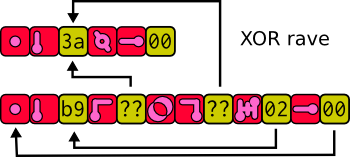Some useful Betablocker DS code patterns as used in common live coding situations.
Firstly, when carrying out a sound check before a live performance it’s important to keep some kinds of sound engineers happy generating as many different sounds as you can so they can fiddle around with stuff – of course remember to turn everything up to 8 when asked to make the loudest sound you can in order to leave some overhead to blow the PA.
This is a betablocker program which will play all the sounds in a sound bank at all frequencies. Add more concurrent threads to make it more interesting. Values interpreted as pointers are visualised as arrows:

(the instruction set description can be found here)
In betablocker the beat is always locked to the instruction cycle rate, so fast changing sounds are a matter of optimisation. One of the most common ways around this (and a good way to start things off in a gig) is to use one fast loop program for playing sounds while another slower program modifies the first by overwriting bits of it.
More to follow in this series. See also evolved betablocker genetic programs.

Leave a Reply to dave's blog of art and programming | Betablocker DS code patterns (part 2) Cancel reply